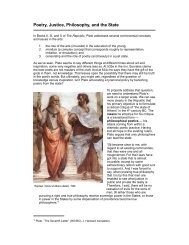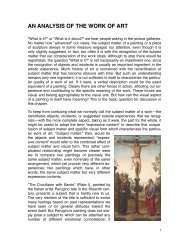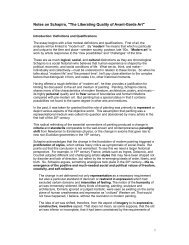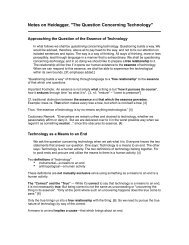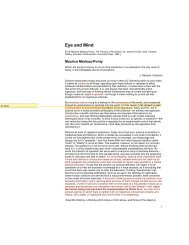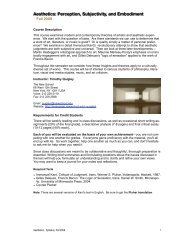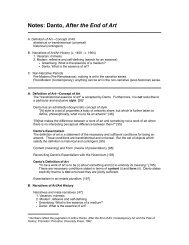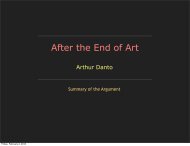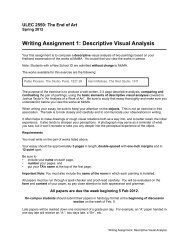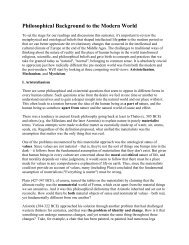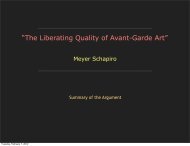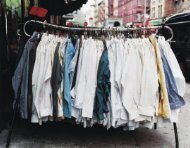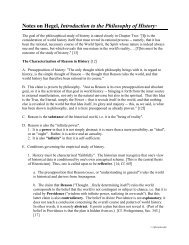The Art of Romare Bearden - Timothy R. Quigley
The Art of Romare Bearden - Timothy R. Quigley
The Art of Romare Bearden - Timothy R. Quigley
Create successful ePaper yourself
Turn your PDF publications into a flip-book with our unique Google optimized e-Paper software.
<strong>The</strong> Massachusetts Review, Inc.<strong>The</strong> <strong>Art</strong> <strong>of</strong> <strong>Romare</strong> <strong>Bearden</strong>Author(s): Ralph EllisonSource: <strong>The</strong> Massachusetts Review, Vol. 18, No. 4 (Winter, 1977), pp. 673-680Published by: <strong>The</strong> Massachusetts Review, Inc.Stable URL: http://www.jstor.org/stable/25088793 .Accessed: 21/08/2011 21:55Your use <strong>of</strong> the JSTOR archive indicates your acceptance <strong>of</strong> the Terms & Conditions <strong>of</strong> Use, available at .http://www.jstor.org/page/info/about/policies/terms.jspJSTOR is a not-for-pr<strong>of</strong>it service that helps scholars, researchers, and students discover, use, and build upon a wide range <strong>of</strong>content in a trusted digital archive. We use information technology and tools to increase productivity and facilitate new forms<strong>of</strong> scholarship. For more information about JSTOR, please contact support@jstor.org.<strong>The</strong> Massachusetts Review, Inc. is collaborating with JSTOR to digitize, preserve and extend access to <strong>The</strong>Massachusetts Review.http://www.jstor.org
<strong>The</strong> MassachusettsReviewbe conveyed by that term. Nor does it help to apply the designation"black" (even more amorphous for conveying a sense <strong>of</strong> culturalcomplexity) and since such terms tell us little about the uniqueindividuality <strong>of</strong> the artist or anyone else, it is well to have them outin the open where they can cause the least confusion.What, then, do I mean by anachronism? I refer to that imbalancein American society which leads to a distorted perception <strong>of</strong> socialreality, to a stubborn blindness to the creative possibilities <strong>of</strong> culturaldiversity, to the prevalence <strong>of</strong> negative myths, racial stereotypes anddangerous illusions about art, humanity and society. Arising from aninitial failure <strong>of</strong> social justice, this anachronism divides social groupsalong lines that are no longer tenable while fostering hostility,anxiety and fear; and in the area to which we now address ourselvesit has had the damaging effect <strong>of</strong> alienating many Negro artistsfrom the traditions, techniques and theories indigenous to the artsthrough which they aspire to achieve themselves.Thus in the field <strong>of</strong> culture, where their freedom <strong>of</strong> self-definitionis at a maximum, and where the techniques <strong>of</strong> artistic self-expressionare most abundantly available, they are so fascinated by the power<strong>of</strong> their anachronistic social imbalance as to limit their efforts todescribing its manifold dimensions and its apparent invincibilityagainst change. Indeed, they take it as a major theme and focus fortheir attention; they allow it to dominate their thinking about themselves, their people, their country and their art. And while many areconvinced that simply to recognize social imbalance is enough toput it to riot, few achieve anything like artistic mastery, and mostfail miserably through a single-minded effort to "tell it like it is."Sadly however, the problem for the plastic artist is not one <strong>of</strong>"telling" at all, but <strong>of</strong> revealing that which has been concealed bytime, by custom, and by our trained incapacity to perceive the truth.Thus it is a matter <strong>of</strong> destroying moribund images <strong>of</strong> reality andcreating the new. Further, for the true artist, working from the top <strong>of</strong>his times and out <strong>of</strong> a conscious concern with the most challengingpossibilities <strong>of</strong> his form, the unassimilated and anachronistic?whether in the shape <strong>of</strong> motif, technique or image?is abhorrent, anevidence <strong>of</strong> conceptual and/or technical failure, <strong>of</strong> challenges unmet. And although he may ignore the anachronistic through a preoccupation with other pressing details, he can never be satisfiedsimply by placing it within a frame. For once there, it becomes thesymbol <strong>of</strong> all that is not art and a mockery <strong>of</strong> his powers <strong>of</strong> creation.So at best he struggles to banish the anachronistic element from hiscanvas by converting it into an element <strong>of</strong> style, a device <strong>of</strong> hispersonal vision.For as <strong>Bearden</strong> demonstrated here so powerfully, it is <strong>of</strong> the true674
<strong>The</strong> <strong>Art</strong> <strong>of</strong> <strong>Romare</strong><strong>Bearden</strong>artist's nature and mode <strong>of</strong> action to dominate all the world and timethrough technique and vision. His mission is to bring a new visualorder into the world, and through his art he seeks to reset society'sclock by imposing upon it his own method <strong>of</strong> defining the times.<strong>The</strong> urge to do
<strong>The</strong> MassachusettsReviewhis mark upon the world through art and his ties to his group andits claims upon him.Fortunately for them and for us, <strong>Romare</strong> <strong>Bearden</strong> has faced thesequestions for himself, and since he is an artist whose social consciousness is no less intense than his dedication to art, his example is<strong>of</strong> utmost importance for all who are concerned with grasping something <strong>of</strong> the complex interrelations between race, culture and theindividual artist as they exist in the United States. <strong>Bearden</strong> isaware that for Negro Americans these are times <strong>of</strong> eloquent protestand intense struggle, times <strong>of</strong> rejection and redefinition?but he alsoknows that all this does little to make the question <strong>of</strong> the relation <strong>of</strong>the Negro artist to painting any less difficult. And if the cries in thestreet are to find effective statement on canvas they must undergoa metamorphosis. For in painting, <strong>Bearden</strong> has recently observed,there is little room for the lachrymose, for self-pity or raw complaint; and if they are to find a place in painting this can only beaccomplished by infusing them with the freshest sensibility <strong>of</strong> thetimes as it finds existence in the elements <strong>of</strong> painting.During the late Thirties when I first became aware <strong>of</strong> <strong>Bearden</strong>'swork, he was painting scenes <strong>of</strong> the Depression in a style stronglyinfluenced by the Mexican muralists. This work was powerful, thescenes grim and brooding, and through his depiction <strong>of</strong> unemployedworkingmen in Harlem he was able, while evoking the Southernpast, to move beyond the usual protest painting <strong>of</strong> that period toreveal something <strong>of</strong> the universal elements <strong>of</strong> an abiding humancondition. By striving to depict the times, by reducing scene, character and atmosphere to a style, he caught both the universality <strong>of</strong>Harlem life and the "harlemness" <strong>of</strong> the national human predicament.I recall that later under the dual influences <strong>of</strong> Hemingway andthe poetic tragedy <strong>of</strong> Frederico Garcia Lorca, <strong>Bearden</strong> created avoluminous series <strong>of</strong> drawings and paintings inspired by Lorca'sLament for Ignacion Sanchez Mejias. He had become interested inmyth and ritual as potent forms for ordering human experience,and it would seem that by stepping back from the immediacy <strong>of</strong> theHarlem experience?which he knew both from boyhood and asa social worker?he was freed to give expression to the essentiallypoetic side <strong>of</strong> his vision. <strong>The</strong> products <strong>of</strong> that period were marked bya palette which in contrast with the somber colors <strong>of</strong> the earlier workand despite the tragic theme with its underlying allusions to Christian rite and mystery, was brightly sensual. And despite their havingbeen consciously influenced by the compositional patterns <strong>of</strong> theItalian primitives, and the Dutch masters, these works were alsoresolutely abstract.676
<strong>The</strong> <strong>Art</strong> <strong>of</strong> <strong>Romare</strong><strong>Bearden</strong>It was as though <strong>Bearden</strong> had decided that in order to possess hisworld artistically he had to confront it not through propaganda orsentimentality, but through the finest techniques and traditions <strong>of</strong>painting. He sought to recreate his Harlem in the light <strong>of</strong> hispainter's vision, and thus he avoided the defeats suffered by many <strong>of</strong>the aspiring painters <strong>of</strong> that period who seemed to have felt that theyhad only to reproduce out <strong>of</strong> a mood <strong>of</strong> protest and despair thescenes and surfaces <strong>of</strong> Harlem, in order to win artistic mastery andaccomplish social transfiguration.It would seem that for many Negro painters even the possibility<strong>of</strong> translating Negro American experience into the modes and conventions <strong>of</strong> modern painting went unrecognized. This was, in part,the result <strong>of</strong> an agonizing fixation upon the racial mysteries andsocial realities dramatized by color, facial structure, and the texture<strong>of</strong> Negro skin and hair. And again, many aspiring artists clung withprotective compulsiveness to the myth <strong>of</strong> the Negro American'stotal alienation from the larger American culture?a culture which hehelped to create in the areas <strong>of</strong> music and literature, and where inthe area <strong>of</strong> painting he has appeared from the earliest days <strong>of</strong> thenation as a symbolic figure?and allowed the realities <strong>of</strong> their socialand political situation to determine their conception <strong>of</strong> their roleand freedom as artists.To accept this form <strong>of</strong> the myth was to accept its twin variants,one <strong>of</strong> which holds that there is a pure mainstream <strong>of</strong> American culture which is "unpolluted" by any trace <strong>of</strong> Negro American style oridiom, and the other (propagated currently by the exponents <strong>of</strong>Negritude) which holds that Western art is basically racist and thusanything more than a cursory knowledge <strong>of</strong> its techniques and history is to the Negro artist irrelevant. In other words, the NegroAmerican who aspired to the title "<strong>Art</strong>ist" was too <strong>of</strong>ten restrictedby sociological notions <strong>of</strong> racial separatism, and these appear notonly to have restricted his use <strong>of</strong> artistic freedom, but to have limitedhis curiosity as to the abundant resources made available to himby those restless and assertive agencies <strong>of</strong> the artistic imaginationwhich we call technique and conscious culture.Indeed, it has been said that these disturbing works <strong>of</strong> <strong>Bearden</strong>'s(which virtually erupted during a tranquil period <strong>of</strong> abstract painting) began quite innocently as a demonstration to a group <strong>of</strong> Negropainters. He was suggesting some <strong>of</strong> the possibilities throughwhich commonplace materials could be forced to undergo a creativemetamorphosis when manipulated by some <strong>of</strong> the non-representational techniques available to the resourceful craftsman. <strong>The</strong> stepfrom collage to projection followed naturally since <strong>Bearden</strong> hadused it during the early Forties as a means <strong>of</strong> studying the works <strong>of</strong>677
<strong>The</strong> MassachusettsReviewsuch early masters as Giotto and de Hooch. That he went on tobecome fascinated with the possibilities lying in such "found" materials is both an important illustrative instance for younger paintersand a source for our delight and wonder.<strong>Bearden</strong> knows that regardless <strong>of</strong> the individual painter's personalhistory, taste or point <strong>of</strong> view, he must, nevertheless, pay his materials the respect <strong>of</strong> approaching them through a highly consciousawareness <strong>of</strong> the resources and limitations <strong>of</strong> the form to which hehas dedicated his creative energies. One suspects also that as anartist possessing a marked gift for pedagogy, he has sought here toreveal a world long hidden by the cliches <strong>of</strong> sociology and renderedcloudy by the distortions <strong>of</strong> newsprint and the false continuity imposed upon our conception <strong>of</strong> Negro life by television and muchdocumentary photography. <strong>The</strong>refore, as he delights us with themagic <strong>of</strong> design and teaches us the ambiguity <strong>of</strong> vision, <strong>Bearden</strong>insists that we see and that we see in depth and by the fresh light<strong>of</strong> the creative vision. <strong>Bearden</strong> knows that the true complexity <strong>of</strong> theslum dweller and the tenant farmer require a release from theprison <strong>of</strong> our media-dulled perception and a reassembling in formswhich would convey something <strong>of</strong> the depth and wonder <strong>of</strong> theNegro American's stubborn humanity.Being aware that the true artist destroys the accepted world byway <strong>of</strong> revealing the unseen, and creating that which is new anduniquely his own, <strong>Bearden</strong> has used cubist techniques to his owningenious effect. His mask-faced Harlemites and tenant farmers setin their mysterious, familiar, but emphatically abstract, scenes arenevertheless resonant <strong>of</strong> artistic and social history. Without compromising their integrity as elements in plastic compositions hisfigures are eloquent <strong>of</strong> a complex reality lying beyond their frames.While functioning as integral elements <strong>of</strong> design they serve simultaneously as signs and symbols <strong>of</strong> a humanity which has struggledto survive the decimating and fragmentizing effects <strong>of</strong> Americansocial processes. Here faces which draw upon the abstract character<strong>of</strong> African sculpture for their composition are made to focus ourattention upon the far from abstract reality <strong>of</strong> a people. Here abstract interiors are presented in which concrete life is acted outunder repressive conditions. Here, too, the poetry <strong>of</strong> the blues isprojected through synthetic forms which, visually, are in themselvestragi-comic and eloquently poetic. A harsh poetry this, but poetrynevertheless; with the nostalgic imagery <strong>of</strong> the blues conceived asvisual form, image, pattern and symbol?including the familiar trains(evoking partings and reconciliations), and the conjur women (whoappear in these works with the ubiquity <strong>of</strong> the witches who haunt thedrawing <strong>of</strong> Goya) who evoke the abiding mystery <strong>of</strong> the enigmatic678
<strong>The</strong> <strong>Art</strong> <strong>of</strong> <strong>Romare</strong> <strong>Bearden</strong>women who people the blues. And here, too, are renderings <strong>of</strong> thoserituals <strong>of</strong> rebirth and dying, <strong>of</strong> baptism and sorcery which giveceremonial continuity to the Negro American community.By imposing his vision upon scenes familiar to us all <strong>Bearden</strong>reveals much <strong>of</strong> the universally human which they conceal. Throughhis creative assemblage he makes complex comments upon history,upon society and upon the nature <strong>of</strong> art. Indeed, his Harlem becomesa place inhabited by people who have in fact been resurrected, recreated by art, a place composed <strong>of</strong> visual puns and artistic allusionsand where the sacred and pr<strong>of</strong>ane, reality and dream are ambiguously mingled. And resurrected with them in the guise <strong>of</strong> fragmentedancestral figures and forgotten gods (really masks <strong>of</strong> the instincts,hopes, emotions, aspirations and dreams) are those powers that nowsurge in our land with a potentially destructive force which springsfrom the very fact <strong>of</strong> their having for so long gone unrecognized,unseen.<strong>Bearden</strong> doesn't impose these powers upon us by explicit comment, but his ability to make the unseen manifest allows us someinsight into the forces which now clash and rage as Negro Americansseek self-definition in the slums <strong>of</strong> our cities. <strong>The</strong>re is a beauty here,a harsh beauty which asserts itself out <strong>of</strong> the horrible fragmentationwhich <strong>Bearden</strong>'s subjects and their environment have undergone.But, as I have said, there is no preaching; these forces have beenbrought to eye by formal art. <strong>The</strong>se works take us from Harlemthrough the south <strong>of</strong> tenant farms and northward-bound trains totribal Africa; our mode <strong>of</strong> conveyance consists <strong>of</strong> every device whichhas claimed <strong>Bearden</strong>'s artistic attention, from the oversimplifiedand scanty images <strong>of</strong> Negroes that appear in our ads and photojournalism, to the discoveries <strong>of</strong> the School <strong>of</strong> Paris and the Bauhaus.He has used the discoveries <strong>of</strong> Giotto and Pieter de Hooch no lessthan those <strong>of</strong> Juan Gris, Picasso, Schwitters and Mondrian (whowas no less fascinated by the visual possibilities <strong>of</strong> jazz than by thecompositional rhythms <strong>of</strong> the early Dutch masters), and has discovered his own uses for the metaphysical richness <strong>of</strong> African sculptural forms. In brief, <strong>Bearden</strong> has used (and most playfully) all <strong>of</strong> hisartistic knowledge and skill to create a curve <strong>of</strong> plastic vision whichreveals to us something <strong>of</strong> the mysterious complexity <strong>of</strong> those whodwell in our urban slums. But his is the eye <strong>of</strong> a painter, not that <strong>of</strong>a sociologist and here the elegant architectural details which existin a setting <strong>of</strong> gracious but neglected streets and the buildings inwhich the hopeful and the hopeless live cheek by jowl, where failedhuman wrecks and the confidently expectant explorers <strong>of</strong> thefrontiers <strong>of</strong> human possibility are crowded together as incongru679
<strong>The</strong> MassachusettsReviewously as the explosive details in a <strong>Bearden</strong> canvas?all this comesacross plastically and with a freshness <strong>of</strong> impact that is impossiblefor sociological cliche or raw protest.Where any number <strong>of</strong> painters have tried to project the "prose" <strong>of</strong>Harlem?a task performed more successfully by photographers?<strong>Bearden</strong> has concentrated upon releasing its poetry, its abidingrituals and ceremonies <strong>of</strong> affirmation?creating a surreal poetry compounded <strong>of</strong> vitality and powerlessness, destructive impulse and theall-pervading and enduring faith in their own style <strong>of</strong> Americanhumanity. Through his faith in the powers <strong>of</strong> art to reveal the unseenthrough the seen his collages have transcended their immaculatenessas plastic constructions.?Or to put it another way, <strong>Bearden</strong>'smeaning is identical with his method. His combination <strong>of</strong> techniqueis in itself eloquent <strong>of</strong> the sharp breaks, leaps in consciousness,distortions, paradoxes, reversals, telescoping <strong>of</strong> time and surrealblending <strong>of</strong> styles, values, hopes and dreams which characterizemuch <strong>of</strong> Negro American history. Through an act <strong>of</strong> creative will,he has blended strange visual harmonies out <strong>of</strong> the shrill, indigenousdichotomies <strong>of</strong> American life and in doing so reflected the irrepressible thrust <strong>of</strong> a people to endure and keep its intimate sense<strong>of</strong> its own identity.<strong>Bearden</strong> seems to have told himself that in order to possess themeaning <strong>of</strong> his Southern childhood and Northern upbringing, thatin order to keep his memories, dreams and values whole, he wouldhave to recreate them, humanize them by reducing them to artisticstyle. Thus in the poetic sense these works give plastic expressionto a vision in which the socially grotesque conceals a tragic beauty,and they embody <strong>Bearden</strong>'s interrogation <strong>of</strong> the empirical values <strong>of</strong>a society which mocks its own ideals through a blindness inducedby its myth <strong>of</strong> race. All this, ironically, by a man who visually atleast (he is light-skinned and perhaps more Russian than 'black' inappearance) need never have been restricted to the social limitations imposed upon easily identified Negroes. <strong>Bearden</strong>'s art is thusnot only an affirmation <strong>of</strong> his own freedom and responsibility as anindividual and artist, it is an affirmation <strong>of</strong> the irrelevance <strong>of</strong> thenotion <strong>of</strong> race as a limiting force in the arts. <strong>The</strong>se are works <strong>of</strong> aman possessing a rare lucidity <strong>of</strong> vision.680



